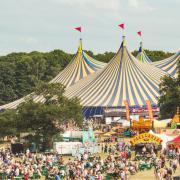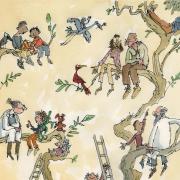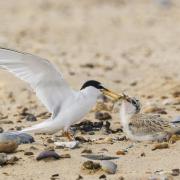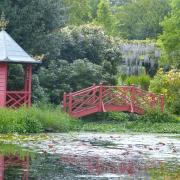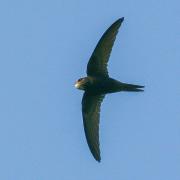I've been invited to Stonham Barns to photograph the work of the Suffolk Owl Sanctuary (SOS) and during my visit, as if on cue, an injured tawny owl arrives in a cardboard box. A member of the public has found the male bird, clearly wounded and in distress, and rushed him over to the rescue centre.
As medics Izzy and Dolly carefully remove the latest admission from his temporary housing, the bird is quickly registered and given the name Blinky. Still subdued, he offers no resistance as the examination begins. Worryingly, Blinky is keeping his right eye closed, and as the team gingerly unfurl his left wing it appears damaged, another cause for concern. Otherwise, the new arrival appears to be in good condition and weighs in at a healthy 376 grams.
In the small, darkened treatment room the two women inspect and photograph the suspect eye and diagnose some bleeding. The damage suggests that Blinky is the victim of a road traffic accident; vehicle collisions are an ever-increasing cause of owl and raptor injuries and fatalities in the county. The SOS medics give the patient a nutritional solution via a feeding tube and administer optical drops to the damaged eye.



Blinky is likely to require a visit to the vet for an x-ray to help diagnose the full extent of his afflictions, but as I photograph him resting on his soft bedding I know he is in expert hands and, if it is at all feasible, the staff at the centre will ensure he will soon be flying free again in Suffolk. In the medical centre I meet another owl, Pumpkin Spice, hurt after becoming entangled in garden netting, another hazard for the nocturnal hunters.
Established as a registered charity in 2001, the Suffolk Owl Sanctuary operates a comprehensive facility for the care and rehabilitation of owls and birds of prey from the region, whilst also promoting owl conservation throughout the UK and beyond.
The hospital at SOS is fully equipped for the treatment of the many injured wild owls and raptors which are brought into the facility every year. Some of these casualties merely require overnight rest and recuperation before being released back into the countryside. Birds that are more seriously injured, but stand a good chance of mid- to long-term recovery, are given medical aid and sometimes surgery, then allowed time and space to fully recover in one of the centre's secluded flight aviaries, before being returned to the wild.


A male common buzzard delivered to SOS by a Stowmarket vet is a typical example of the charity’s work. The bird was suffering major trauma to its left eye and six primary wing feathers on the same side of the body were also badly damaged, probably another casualty of a collision with a vehicle. Following a short course of treatment with anti-inflammatory drugs and antibiotics, the buzzard’s eye healed perfectly. This just left the problem of the broken wing feathers, which would prevent the buzzard from being able yo hunt efficiently in the wild.
Using an innovative technique, staff took moulted feathers from other birds at the rescue centre and matched them with the buzzard’s damaged primaries. In the hospital the broken primaries were removed, and the replacement feathers were delicately implanted to the wing. The procedure was a success, and the patient was able to regain his fitness in a flight aviary.
Five weeks after his admission, Dolly and Matt transported the healed bird of prey to a field in the Suffolk countryside close to where he was found and gave him back his liberty. He was soon wheeling above the treeline, and within minutes was joined by two other mewing buzzards. Friends reunited perhaps? It’s obvious why releases are the most rewarding activity for SOS staff.

In addition to injured adult owls and raptors, the sanctuary also receives a number of nestling birds each year. These require specialised handling from the charity’s 'Hack-Back' team, who also manage the complex rehabilitation of birds that have had an extended recuperation period in captivity.
A temporary hack aviary comprised of an enlarged nest box with a mesh covered outdoor area, is usually sited on farmland, with the support of local landowners. From this safe haven the birds are gradually reintroduced to their natural environment. Food is provided regularly until eventually the birds become self-sufficient and no longer feel the need to return for a free meal.
As part of its important conservation work, SOS Wild Owl Nest Box Scheme involves the time-consuming search for suitable locations for man-made nest boxes. The chief determining factors are availability of suitable habitat with sufficient natural prey species, and the cooperation of landowners. The boxes are constructed from safe, durable, environmentally friendly materials and once they're erected in suitable locations the team must monitor the success of any nesting activity.
Artificial nesting locations have been a pivotal factor in the resurgence of Suffolk’s barn owl population in recent years. From an estimated low of just 45 pairs at the turn of the century there has been a ten-fold increase in their numbers. SOS consult with landowners and farmers and offer advice for those interested in developing suitable habitat or nesting locations for owls in the wild.
Conservation and education go hand-in-hand at SOS and they can organise bespoke visits for schools, youth clubs or community groups, including curriculum linked activities. Dissecting regurgitated owl pellets to reveal the skulls, bones and other prey remains is always a favourite task for inquisitive children.


There is also an international strand to the charity’s work. Last year the resident pair of hooded vultures successfully raised a chick and their offspring, Toto, is now living at the centre independently of its parents. It is hoped that, at some point, vultures bred at Stonham Barns may be able to be released back into their African homeland where they are critically endangered.
Vultures are often considered the 'Ugly Sisters' of the raptor family, but they do the critical role of carcass disposal, thereby helping to prevent the spread of diseases. Personally, I admire these much maligned scavengers, so during my visit I jump at the opportunity to photograph the three birds.
I follow Dolly into the parents’ aviary and photograph the pair which are getting ready to breed again. I grab some photos of the two together before moving into the second aviary where the juvenile Toto is being fed by Jade. Toto is totally focused on the food, flying from perch to perch to seize each morsel.
It is hoped he will become part of the sanctuary’s summer flying displays this year, acting as an ambassador for his species and educating the public about the importance of vultures and the many threats they face in the wild.
The sanctuary at Stonham Barns is open to the public all year round. owl-help.org.uk. It also operates a helpline for advice on owls and birds of prey requiring assistance: T 03456 807897.
















